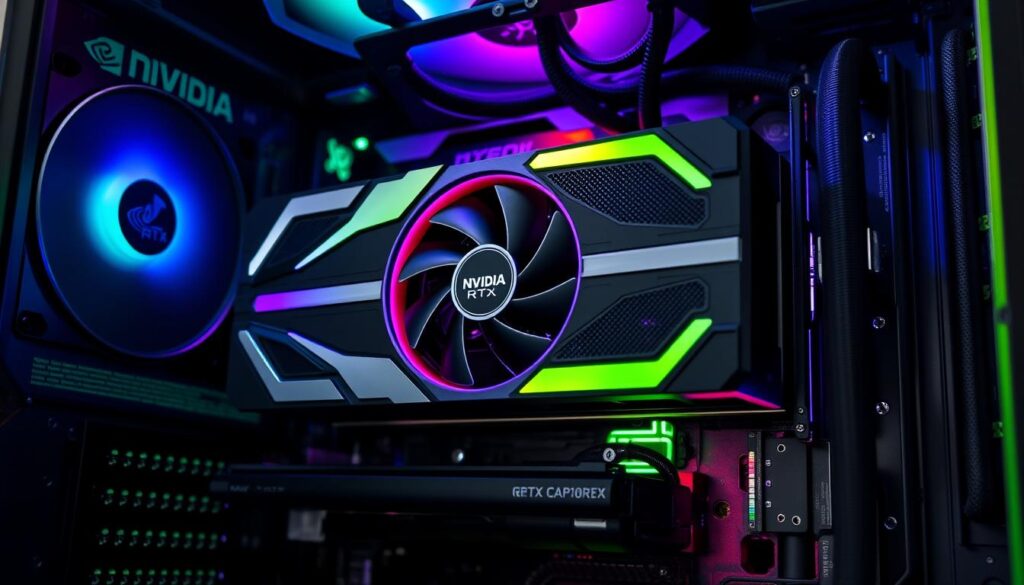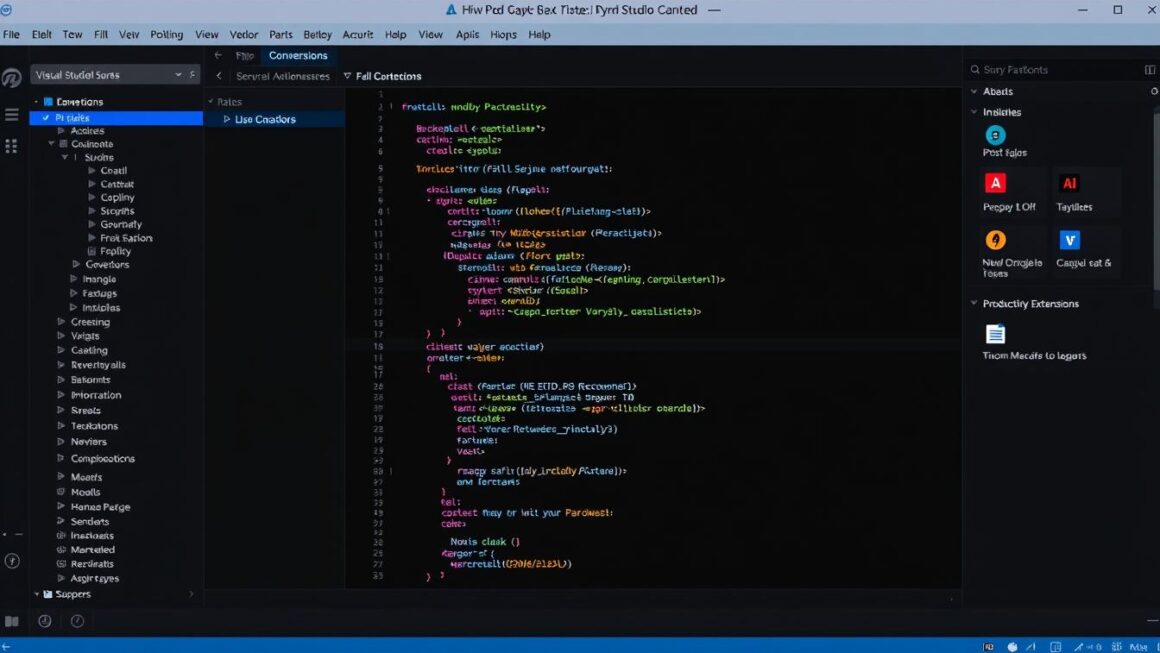The graphic processor market has become a battleground between tech giants, with the PC gaming market alone raking in over $30 billion in revenue in 2016 and growing by more than 20% from the previous year.
The rivalry between the top contenders has intensified dramatically in 2025, with both companies vying for dominance in multiple segments. One company maintains its stronghold in high-performance computing and AI sectors, while the other positions itself as a value leader with competitive performance at more accessible price points.
As the competition heats up, the battle extends beyond raw performance metrics to include software ecosystems, with significant advantages held by one company’s proprietary platform over the other’s open-source alternative.
Key Takeaways
- The GPU market is highly competitive, with two major players.
- One company dominates high-performance computing and AI.
- The other company offers competitive performance at lower prices.
- Software ecosystems play a crucial role in the competition.
- The rivalry impacts both consumers and enterprise users.
- The market is expected to continue growing.
The Current State of the GPU Battlefield
NVIDIA and AMD are locked in a fierce struggle for supremacy in the GPU market, driven by advancements in AI and gaming. The competition between these two giants is shaping the future of the industry.
NVIDIA’s Market Dominance
NVIDIA has long been the dominant player in the GPU market, thanks to its high-performance graphics cards and powerful AI computing hardware. The company’s CUDA ecosystem has become the industry standard for AI development, giving NVIDIA a significant edge. As a result, NVIDIA continues to hold a substantial market share, driven by its strong brand reputation and innovative product lineup.
AMD’s Strategic Positioning
AMD, on the other hand, is making significant strides with its RDNA4 architecture, offering competitive gaming performance at more attractive price points. By focusing on delivering value to customers, AMD is positioning itself as a viable alternative to NVIDIA. The company’s open-standards approach, including ROCm for AI, is gaining traction, especially in cost-sensitive markets. Under the leadership of CEO Lisa Su, AMD has executed a remarkable turnaround, transforming from a struggling company to a serious competitor in high-performance computing.
AMD’s strategic acquisitions, such as Xilinx and Silo AI, have strengthened its position in adaptive computing and AI capabilities. As AMD continues to grow its revenue, with an expected growth rate of 21.9% in 2024, the company is poised to challenge NVIDIA’s dominance in the GPU industry.
NVIDIA vs AMD: GPU War Heats Up as AI, Gaming, and Price Battles Intensify

As NVIDIA and AMD engage in an intensifying GPU war, the stakes are higher than ever, with AI, gaming, and pricing strategies at the forefront. The competition between these two giants is not just about technological superiority but also about market dominance and user preference.
Key Factors Driving the Competition
The semiconductor industry is entering an exciting phase fueled by continuous innovation. Sustained innovation is crucial for success, and it’s not just about a single chip breakthrough. AMD is making significant strides with its RDNA4 architecture, offering competitive gaming performance at better price points. Its open standards, like ROCm for AI, are gaining traction, especially in cost-sensitive markets.
The key factors driving this competition include advancements in AI capabilities, gaming performance, and pricing strategies. As both companies push the boundaries of what their GPUs can do, consumers and enterprise users stand to benefit from improved performance and lower costs.
| Company | Key Strengths | Market Focus |
|---|---|---|
| NVIDIA | CUDA ecosystem, high-end performance | Premium market segment |
| AMD | RDNA4 architecture, competitive pricing | Cost-sensitive markets |
Impact on Consumers and Enterprise Users
The intensifying competition between NVIDIA and AMD is ultimately beneficial for consumers and enterprise users. Gamers now have more options across different price points, with NVIDIA offering premium performance and AMD providing strong value alternatives. Enterprise users benefit from having multiple viable options for AI and data center applications, reducing dependency on a single vendor.
Developers face both opportunities and challenges, with NVIDIA’s mature CUDA ecosystem offering stability and performance, while AMD’s open standards approach promises greater flexibility. The competition is accelerating the pace of innovation in both hardware and software, driving better performance, efficiency, and usability.
As the competition between NVIDIA and AMD continues to heat up, you can expect significant advancements in GPU technology, benefiting both consumers and enterprise users. With more options available across different price points, the market is becoming increasingly competitive, driving innovation and lowering costs.
AI Capabilities: CUDA vs ROCm
CUDA and ROCm are at the forefront of the AI revolution, representing NVIDIA and AMD’s respective approaches to AI processing. As you explore the capabilities of these architectures, it’s essential to understand their strengths and weaknesses in handling various AI workloads.
NVIDIA’s CUDA Ecosystem Advantage
NVIDIA’s CUDA has established a strong presence in the AI landscape, particularly in large-scale model development and training workloads. Its mature software stack and superior multi-node scaling capabilities make it the preferred choice for many enterprise AI applications. CUDA’s extensive ecosystem supports a wide range of AI frameworks and tools, providing developers with a comprehensive platform for building and deploying AI models.
AMD’s ROCm and Open Standards Approach
AMD’s ROCm, on the other hand, is gaining traction with its open standards approach and competitive performance in certain AI workloads. ROCm’s ability to support inference tasks efficiently, particularly for models that fit within a single server’s memory, positions it as a viable alternative for specific use cases. The MI300X GPU, for instance, excels in workloads where the model can be contained within a single server, typically with 8 GPUs.
Performance Comparisons in AI Workloads
When comparing the performance of NVIDIA and AMD in AI workloads, the picture is nuanced. For AI training, NVIDIA maintains an advantage due to its superior multi-node scaling and more mature software stack. However, in inference workloads, AMD has shown competitive and sometimes superior performance, particularly for models that can fit within a single server’s memory capacity. The shift in the AI industry from training to inference workloads potentially plays to AMD’s strengths, as many deployment scenarios don’t require the advanced interconnect capabilities where NVIDIA excels.
Recent advancements in model quantization and optimization techniques are further leveling the playing field between the two companies. As you evaluate your AI needs, understanding the specific requirements of your models and workloads will be crucial in choosing between CUDA and ROCm.
Gaming Performance and Value Proposition
As gamers, you’re at the forefront of a heated competition between NVIDIA and AMD, with each company striving to outdo the other in gaming performance and affordability. This rivalry is driving innovation, resulting in better hardware and software for consumers.
NVIDIA’s High-End Gaming Solutions
NVIDIA’s high-end GPUs, such as those in the RTX series, offer unparalleled gaming performance with advanced features like ray tracing and DLSS. These GPUs are designed for gamers seeking the best possible experience.

AMD’s RDNA4 Architecture and Price-to-Performance Ratio
AMD’s RDNA4 architecture brings significant improvements in performance and efficiency, making AMD GPUs an attractive option for gamers looking for high-quality graphics at a lower price point. AMD focuses on delivering a great price-to-performance ratio.

Which GPU Brand Offers Better Value for Gamers?
The answer depends on your gaming needs and budget. NVIDIA excels in raw performance and features like ray tracing, while AMD offers competitive performance at a lower cost. Ultimately, the choice between NVIDIA and AMD depends on your priorities and the specific hardware and software features that matter most to you.
Both companies are pushing the edge of what’s possible in gaming, driving the industry forward and benefiting gamers with better performance and more affordable options over time. As the competition continues, the potential for even more innovative gpu and chip designs is vast.
Price Wars and Market Strategies

As NVIDIA and AMD vie for dominance, their pricing strategies are having a significant impact on the market. You are at the forefront of this technological battle, with your choices influencing the direction of the industry.
NVIDIA’s Premium Pricing Model
NVIDIA has maintained a premium pricing strategy, focusing on high-margin segments such as AI data centers and high-end gaming. This approach has allowed NVIDIA to sustain its market dominance and dominance in the AI computing space, where its CUDA ecosystem is unparalleled. However, this premium pricing may limit its appeal in more price-sensitive segments.
AMD’s Competitive Pricing Strategy
In contrast, AMD has adopted a competitive pricing strategy, targeting mid-range gaming and cost-sensitive enterprise deployments. By offering high-performance GPUs at lower prices, AMD has been able to gain market share and challenge NVIDIA’s position. This value-oriented approach has made AMD an attractive option for gamers and businesses looking for affordable, high-quality hardware.
How Pricing Affects Market Share
The pricing strategies employed by NVIDIA and AMD have a significant impact on their respective market shares. While NVIDIA’s premium pricing maintains its lead in high-end segments, AMD’s competitive pricing allows it to capture a larger share of the mid-range market. The table below illustrates the impact of pricing on market share dynamics.
| Segment | NVIDIA Market Share | AMD Market Share |
|---|---|---|
| High-End Gaming | 80% | 20% |
| Mid-Range Gaming | 40% | 60% |
| AI Data Center | 85% | 15% |
The dynamic between pricing and market share continues to evolve as both companies adjust their strategies in response to competitive pressures, technological advancements, and changing market conditions. As you navigate this complex landscape, understanding the implications of these pricing strategies will be crucial for making informed decisions about your hardware investments.
Conclusion: The Future of the NVIDIA-AMD Rivalry
The ongoing rivalry between NVIDIA and AMD is set to intensify as both companies push the boundaries of GPU technology. While NVIDIA leads in raw performance and enterprise AI, AMD is carving out a strong niche in affordability, gaming, and open hardware. As both companies evolve, the winner will be the one who can best balance power, price, and accessibility.
NVIDIA is expected to maintain its leadership position in AI and high-performance computing, leveraging its software ecosystem advantages. AMD, however, has significant growth potential in the inference market and mid-range gaming segments, driven by its competitive pricing and improving software stack.
The competition will drive innovation and put downward pressure on prices, making advanced GPU capabilities more accessible. The ultimate winner will be the company that best balances performance, price, accessibility, and software ecosystem. For now, that competition remains far from decided.



